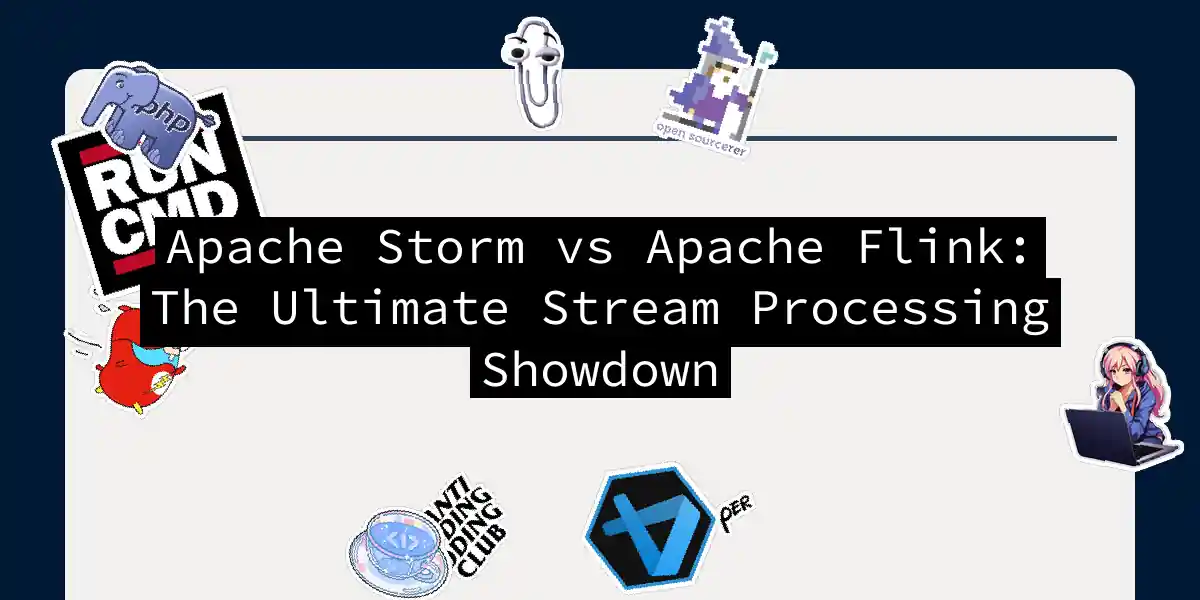When it comes to the world of real-time data processing, two names often come to the forefront: Apache Storm and Apache Flink. Both are battle-tested frameworks, but they approach the challenge of stream processing from different angles. In this article, we’ll delve into the intricacies of each, comparing their processing models, fault tolerance, time handling, ease of use, and more. So, buckle up and let’s dive into the ultimate stream processing showdown.
Processing Model
The processing model is where the rubber meets the road for any stream processing framework. Here’s how our contenders stack up:
Apache Storm: Storm uses a tuple-at-a-time processing model. This means each tuple (a collection of values) is processed independently as it flows through the topology. This approach is straightforward and efficient but lacks the sophistication of more advanced processing models.
Apache Flink: Flink, on the other hand, employs a record-at-a-time processing model, similar to Storm but with a twist. Flink supports strong event-time processing, which is crucial for handling out-of-order events and ensuring accurate results. This makes Flink particularly adept at complex, stateful computations.
Fault Tolerance
Fault tolerance is a critical aspect of any distributed system, and both Storm and Flink have their strategies:
Apache Storm: Storm offers fault tolerance through its distributed architecture, which can detect and recover from failures automatically. However, it does not natively support state management, which means you need to implement it manually if required.
Apache Flink: Flink takes fault tolerance to the next level with its managed, local state and exactly-once processing semantics. This ensures that even in the event of failures, Flink can recover without losing data or duplicating it. Flink’s checkpointing and savepoints mechanisms further enhance its reliability.
Time Handling
Time handling is a nuanced topic in stream processing, and both frameworks have different approaches:
Apache Storm: Storm primarily focuses on processing-time semantics, which means it processes data as soon as it arrives. While this is great for low-latency applications, it can be less accurate for scenarios where event-time is crucial.
Apache Flink: Flink shines in this area with robust support for event-time, processing-time, and ingestion-time semantics. It uses watermarks to handle out-of-order events, ensuring that your processing is accurate and reliable even in complex scenarios.
Ease of Use
Ease of use is a significant factor when choosing a stream processing framework. Here’s how our contenders fare:
Apache Storm: Storm has a steeper learning curve due to its lower-level abstractions. While it is capable, it requires more manual effort to set up and manage, especially when it comes to state management.
Apache Flink: Flink, on the other hand, offers a more complex but clear and concise API. It provides a high-level API that makes it easier to handle complex stream processing tasks, including stateful computations and event-time processing.
Performance and Throughput
Performance and throughput are critical metrics for any stream processing framework:
Apache Storm: Storm is designed for high-performance data processing and can handle large volumes of data in real-time. It excels in low-latency applications and is optimized to minimize processing delays.
Apache Flink: Flink also offers high performance for both batch and stream processing tasks. It uses optimization techniques like pipelining and operator chaining to achieve high throughput and low latency. Flink’s memory efficiency is particularly noteworthy, allowing it to handle large workloads without compromising on speed.
Monitoring and Management
Monitoring and management are essential for maintaining and optimizing your stream processing pipelines:
Apache Storm: Storm provides extensive monitoring and management features, including metrics and logging. This allows developers to monitor the performance of their data processing workflows and make necessary adjustments.
Apache Flink: Flink also offers robust monitoring and management tools, such as the Flink Web UI, Flink Metrics, and integration with other monitoring tools like Prometheus and Grafana. This makes it easier to manage and optimize Flink clusters.
Conclusion
Choosing between Apache Storm and Apache Flink is not a one-size-fits-all decision. Here are some final thoughts to help you make an informed choice:
Use Apache Storm if you need a framework that excels in low-latency, high-throughput applications and are comfortable with a steeper learning curve. Storm is ideal for real-time analytics and online machine learning where immediate processing is crucial.
Use Apache Flink if you require a more unified architecture that seamlessly integrates both batch and stream processing. Flink is perfect for complex, stateful computations and event-time processing, offering robust fault tolerance and high performance.
In the end, the choice between Storm and Flink depends on your specific needs and the complexity of your use case. Both frameworks are powerful tools in the world of stream processing, and understanding their strengths and weaknesses will help you make the right decision for your project.
So, which one will you choose? The low-latency champion, Apache Storm, or the versatile and powerful Apache Flink? The decision is yours, but with this detailed comparison, you’re well-equipped to make an informed choice that will drive your real-time data processing to new heights.
